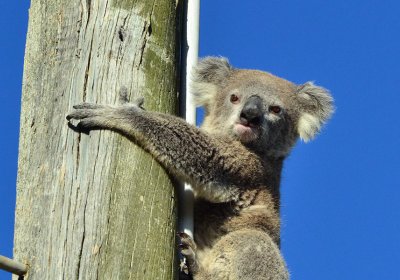About 100 people rallied at Djarrbarrgalli (Domain) on November 6 as part of a week of action for koalas across New South Wales, reports Isaac Nellist.
Koala
Koalas, the popular but endangered marsupial native, seem to have been the cause of a ruckus inside the NSW Coalition, writes Jim McIlroy.
As New South Wales eases its coronavirus restrictions, the North East Forest Alliance took their anti-logging message to a state forest near Casino, in the state's north, reports Kerry Smith.
The NSW Coalition government’s long anticipated Koala Strategy, which was released on May 6, has been condemned as inadequate and doomed to fail by conservation groups, which say it ignores the key threat of habitat loss.
The ubiquitous Commonwealth Games mascot Borobi the blue koala belies the fate of the “Aussie icon” it represents. It is ironic that Borobis flourish in the very region where koala numbers have declined drastically in recent years.
Koalas are an endangered species in Queensland, NSW and the ACT and land clearing has long been recognised as the culprit. As well as the animals killed during the actual process of land clearing, the destruction of habitat results in increasing population losses.
Koalas on the NSW North Coast are threatened with extinction by proposed increases in logging intensity and imminent extensions of timber contracts, according to the North East Forest Alliance.
NEFA spokesperson Dailan Pugh said: “In order to meet current wood supply contracts, the NSW Government plans to zone most of the coastal state forests for intensive logging and clearfelling, and to remove the already inadequate protection for core koala habitat.
Just weeks after a report highlighted plummeting koala populations, the federal government has given approved for coal seam gas (CSG) company QGC to bulldoze 54 hectares of koala habitat on Queensland's Western Downs.
An interim report from the Koala Expert Panel, established by the state government after a catastrophic koala population crash in south-east Queensland last year, has offered little hope for the state’s faunal emblem.
Conservationists say the Strzelecki Ranges hold “one of the most important koala populations in Australia”, after completing surveys that may suggest a population of several thousand koalas across the region.
Surveys conducted in Victoria's Strzelecki Ranges and South Gippsland over 2013–2016 indicate a population of almost 1000 koalas in the 10,500 hectare area surveyed, koala expert Dr Steve Phillips told Green Left Weekly.
- Previous page
- Page 2
- Next page










